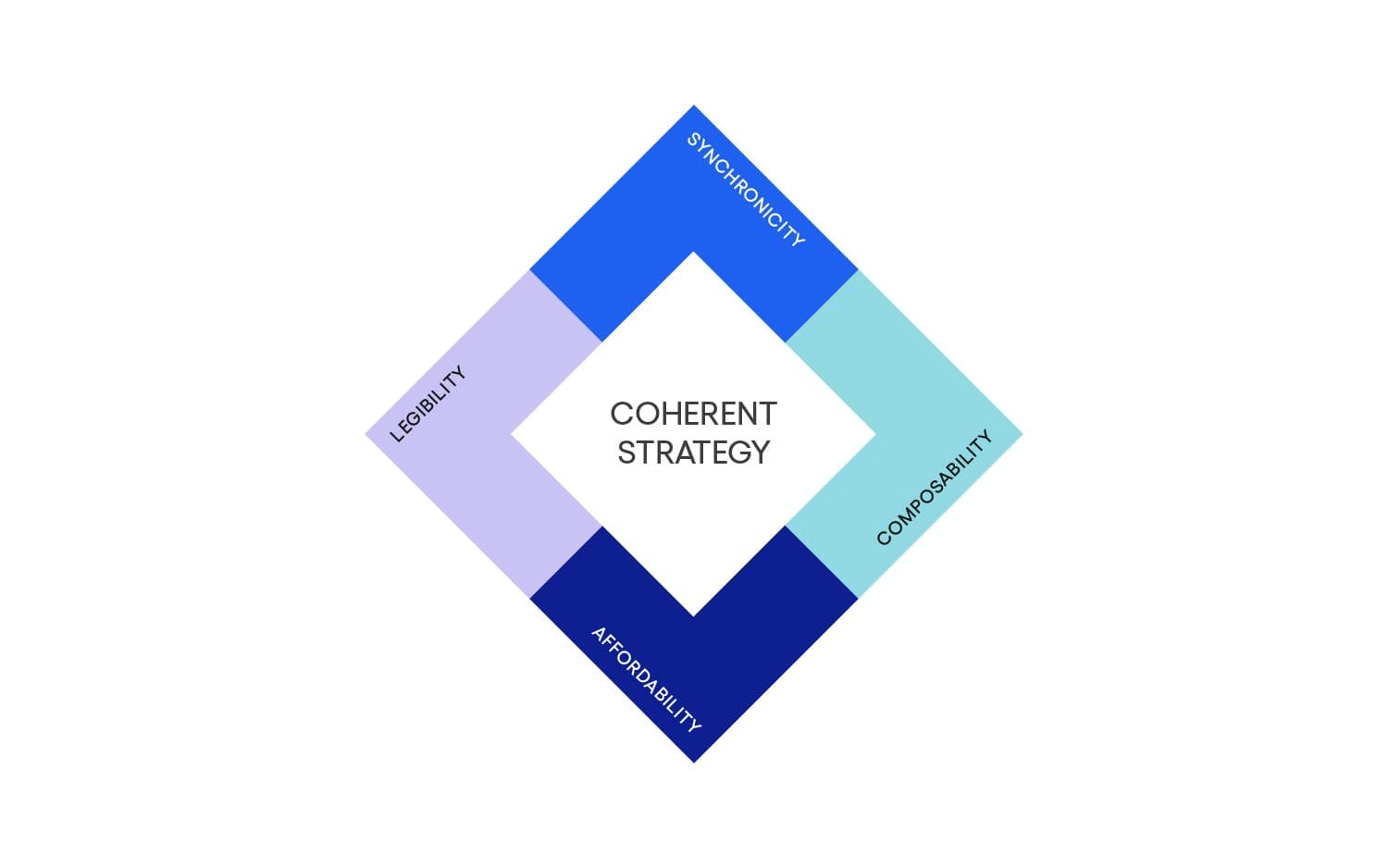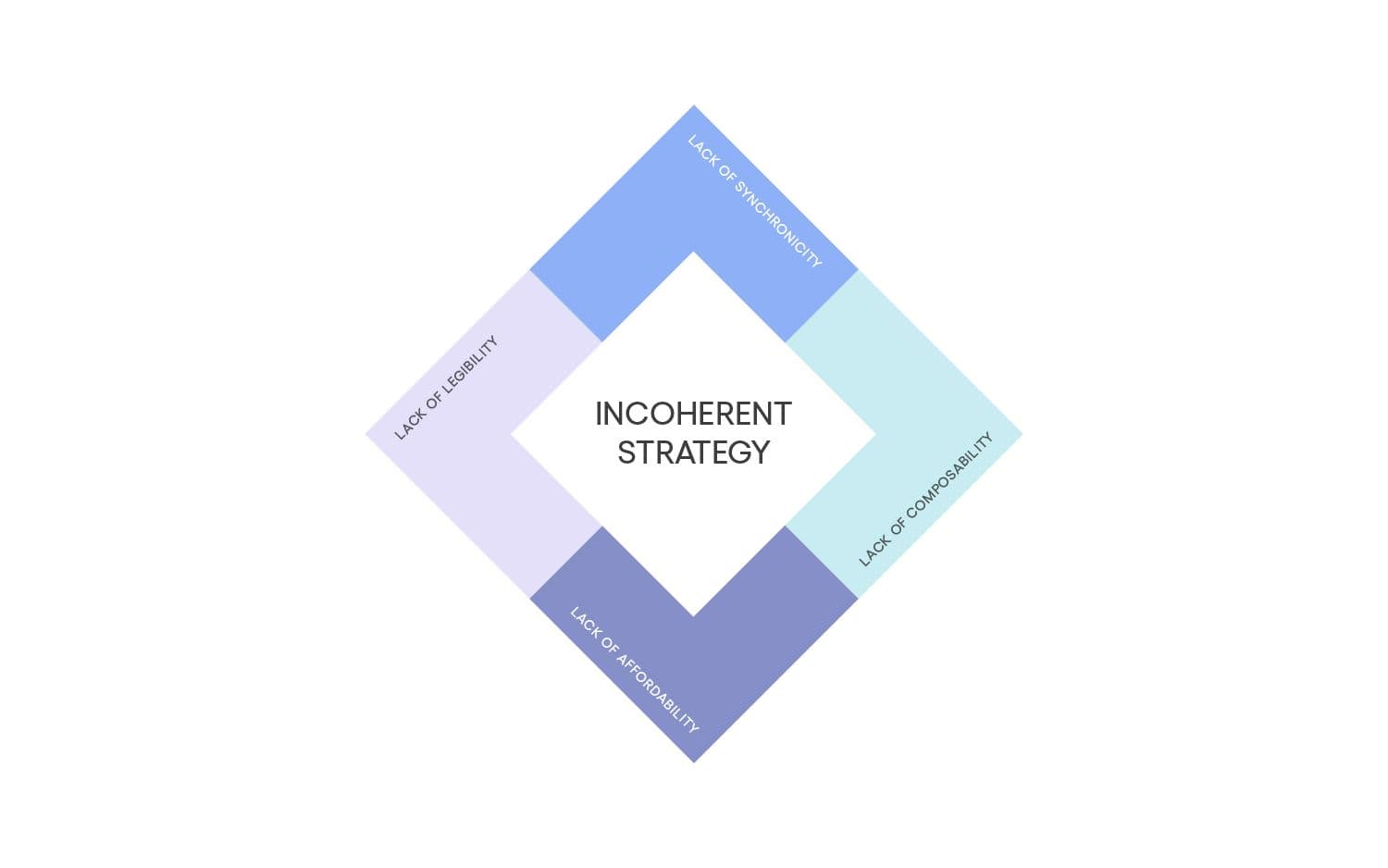Staying Synced on Strategy: The Four Dimensions of Coherence
Learn what four dimensions will help you set a coherent strategy and keep your team aligned.
I’ve been getting some great topic ideas from reader comments on my blog posts—a recent question that got me thinking:
Are there systematic practices to prevent disoriented teams in the first place?
Here are my thoughts.
Strategy (an overused word, I know) is the glue that keeps teams oriented—so any systemic practices designed to prevent organizational drift have to lean on strategy as the foundation. But what makes one strategy better or worse than another in terms of keeping teams oriented? The answer is coherence. What I mean by coherence is that the strategy clicks for an organization, like all the puzzle pieces coming together; conversely, an incoherent strategy has one or more aspects that don’t quite fit.
There are four dimensions of coherence that I’ll discuss:
- Legibility
- Synchronicity
- Composability
- Affordability
Legibility
When a strategy is legible, it’s easy for folks to digest. It’s clearly written, well synthesized, chunked into digestible pieces, and ideally summarized into a compelling visual or tagline. We’ve all seen, read, and heard strategies that overly rely on buzz words and rambling explanations—legibility means short and sweet. And when a strategy is legible, it enables and empowers teams to make decisions and trade-offs at a local level instead of escalating things up the chain.

Synchronicity
A strategy is synchronous when the organizational design aligns with it; in other words, a strategy has to navigate the hierarchy of a company. Of course, communication is critical and repetition is necessary, but if the hierarchy implicitly re-broadcasts the strategy, you get maximum distribution and alignment. There are many mechanisms to share and drive accountability (OKRs, DRIs, etc.), but at the end of the day, if a strategy is creating friction by going against cultural norms, communication channels, and standard practices, it’ll be hard to execute. What this also means is that sometimes a re-org is required to run with a strategy; given how expensive org changes are, you’ll need a legible strategy for folks to buy in.

Composability
Executing a strategy can be a delicate dance—composability means the sequencing is correct. There’s a logical ordering to a well-laid plan, and not every workstream needs to be kicked off in parallel in a mad dash to the finish line. The science behind a well-composed strategy consists of proper scoping, accurate sizing, reasonable staffing, and dependency management. The less composable a strategy is, the more dragged down it is by coordination overhead.

Affordability
Affordability is an idea you might not have thought of that comes into play often. Just because a strategy is legible, the org is aligned, and the plan is logical doesn’t mean the org has the stomach to actually do it. Strategic execution requires (sometimes very hard) trade-offs and you have to say no (or no more) to many things in the interest of saying yes to the main thing. The willingness to make someone (employees, partners, customers) unhappy in the short term for a payoff in the long term is affordability—not every company is willing to pay the price.

Setting a coherent strategy
In summary, if all these factors come together properly, you have a coherent strategy:
- Legibility: Written clearly
- Synchronicity: Broadcasted regularly
- Composability: Planned logically
- Affordability: Executed effortlessly

And when one (or all) of these areas don’t click, incoherence, and ultimately disoriented teams, are the end result.

If you’re building a product strategy in particular, learn more about making it coherent by reading the North Star Playbook or filling out a Product Strategy Template.
Further reading & references
- The original post on Disoriented Teams that led to this article.
- In Implementing Product Strategy, you can read more about legibility and synchronicity, and why they’re critical concepts for rolling out a strategy.
- For some audio thoughts on how to roll out a strategy based on where your organization is at in its ability to execute, listen to Strategy Sophistication.
- Thoughts on some common processes and frameworks that revolve around strategy: quarterly planning tips, OKR myths, and CX loops.
- In order to determine whether a strategy checks the affordability box in terms of trade-offs required, it’s useful to gauge where your product is in terms of its lifecycle.
- If you are dealing with an incoherent strategy, it might be time to do a GIGO check.

Ibrahim Bashir
Former VP of Product, Amplitude
Ibrahim Bashir has been building and shipping software for over 20 years. A former VP of Product at Amplitude, he also scaled Box's platform ecosystem, Twitter's service infrastructure, and Amazon's Kindle business. And in past lives, he studied computer science, taught algorithms courses, wrote radiology software, built ecommerce platforms, and served as a technology consultant. Ibrahim is also a prolific creator of content around the discipline of product management and the craft of cross-functional leadership. You can consume his latest musings via his Substack newsletter Run the Business.
More from Ibrahim





